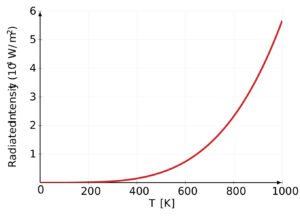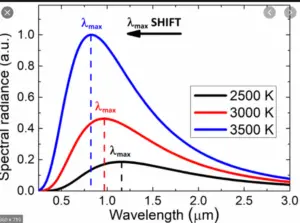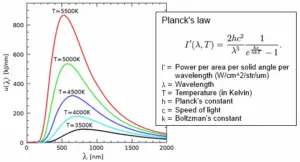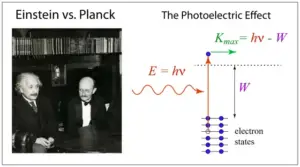The physical world around us is characterized by electromagnetic radiation, which covers a wide range of energy from radio waves with longer wavelengths to gamma rays with shorter wavelengths. This spectrum of electromagnetic waves is essential to our daily lives and has significant applications in various scientific fields.
For centuries, the wave nature of electromagnetic radiation has fascinated and intrigued scientists and researchers. Its discovery and exploration have significantly contributed to our comprehension of the universe, both at the macroscopic and microscopic levels. The concept of wave-particle duality, which brought about a revolution in the field of physics in the early 20th century, is at the very heart of this exploration.
In this article, we will explore the fascinating world of electromagnetic radiation and its wave nature. We will learn about the different properties of waves, including amplitude, wavelength, frequency, and the constant speed of light, which acts as a speed limit for these waves in a vacuum. So let’s get started.
What is electromagnetic radiation?
Electromagnetic radiation definition: Electromagnetic radiation is the propagation of energy through space in the form of electromagnetic waves. These waves consist of oscillating electric and magnetic fields, which are perpendicular to each other and also perpendicular to the direction in which the wave travels.

Electromagnetic radiation encompasses a broad range of frequencies and wavelengths, collectively known as the electromagnetic spectrum. The spectrum includes various types of electromagnetic waves, such as radio waves, microwaves, infrared radiation, visible light, ultraviolet radiation, X-rays, and gamma rays. Each type of electromagnetic radiation has its own unique properties and interactions with matter.
Read Also
- Uncertainty in measurement chemistry, class 11 NCERT
- Laws of chemical combination: chemistry class 11, NCERT
- John dalton’s atomic theory: postulates & limitations, class 11, NCERT
Properties of wave nature of Electromagnetic radiation
Waves are fundamental phenomena that can be observed in various forms, including electromagnetic waves. Understanding the properties of waves is crucial for comprehending the behavior of electromagnetic radiation. In this section, we will explore the key properties that characterize waves and how they relate to electromagnetic waves.
Amplitude
The amplitude of a wave refers to the maximum displacement of particles in the medium through which the wave travels. For electromagnetic waves, the amplitude represents the maximum intensity or strength of the electric and magnetic fields comprising the wave. In practical terms, the amplitude of an electromagnetic wave influences the brightness of light or the strength of a radio signal.
Wavelength
The wavelength of a wave is the distance between two consecutive points that are in phase, such as two consecutive peaks or troughs. In the case of electromagnetic waves, the wavelength is the distance between successive crests or troughs in the electric and magnetic fields. Wavelength is usually denoted by the Greek letter lambda (λ). Different regions of the electromagnetic spectrum have varying wavelengths, with radio waves having long wavelengths and gamma rays having extremely short wavelengths.
Frequency
The frequency of a wave refers to the number of complete oscillations or cycles that occur in a given time. It is usually measured in hertz (Hz), where one hertz equals one cycle per second. In the context of electromagnetic waves, frequency determines the color of visible light or the tuning of a radio station. The relationship between frequency (f), wavelength (λ), and the speed of light (c) in a vacuum is given by the equation: $c = \lambda f$.
Speed of Light
The speed of light (c) in a vacuum is a fundamental constant of nature, approximately 299,792,458 meters per second (approximately 300,000 kilometers per second). Regardless of the wavelength or frequency of electromagnetic waves, they all travel at this constant speed when in a vacuum. The speed of light is a fundamental constant in physics and plays a crucial role in understanding the behavior of electromagnetic radiation.
The properties of amplitude, wavelength, frequency, and speed of light are all interrelated and essential for distinguishing between different types of waves, such as electromagnetic waves. They help us explain the characteristics of electromagnetic radiation and its interactions with matter and other waves. Knowing these properties is essential for a variety of applications, such as designing communication systems and observing distant celestial objects with telescopes.
The Electromagnetic Spectrum
The electromagnetic spectrum is a vast range of electromagnetic radiation, encompassing an array of wavelengths and frequencies. This spectrum plays a central role in various aspects of our daily lives, as well as in scientific research and technological advancements. In this section, we will explore the different regions of the electromagnetic spectrum and their diverse applications.
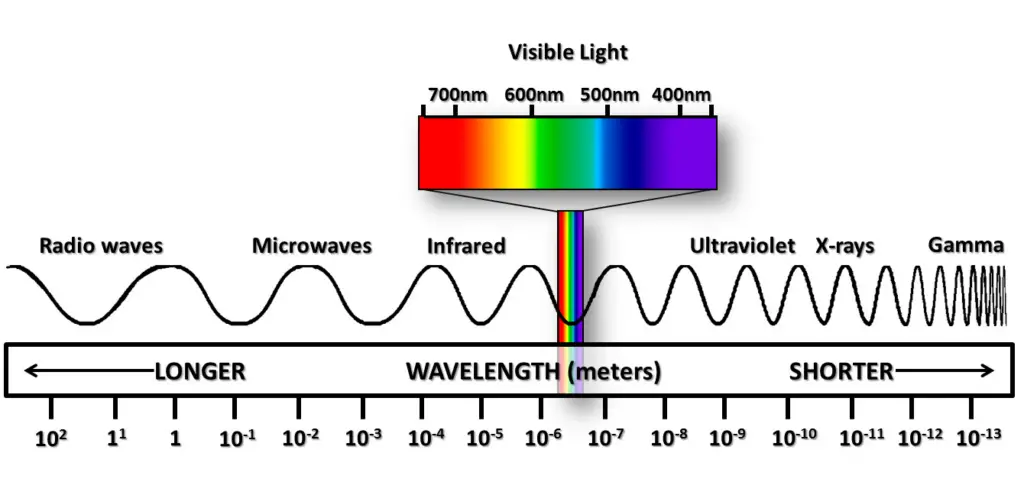
Bug Tussel Wireless
Overview of the Electromagnetic Spectrum
The electromagnetic spectrum spans an enormous range of frequencies and wavelengths, from extremely long waves with low frequencies, such as radio waves, to extremely short waves with high frequencies, such as gamma rays. This spectrum includes the following regions:
- Radio Waves:
- Longest wavelengths and lowest frequencies in the spectrum.
- Used in radio broadcasting, communication systems, and radar technology.
- Microwaves:
- Shorter wavelengths and higher frequencies compared to radio waves.
- Utilized in microwave ovens, satellite communication, and wireless data transmission.
- Infrared Radiation:
- Wavelengths just beyond the visible light range.
- Used in remote controls, thermal imaging, and some medical applications.
- Visible Light:
- The portion of the electromagnetic spectrum is visible to the human eye.
- Comprises various colors, each with a specific wavelength, ranging from violet (shortest) to red (longest).
- Ultraviolet Radiation:
- Shorter wavelengths than visible light.
- Responsible for sunburns and tanning, used in germicidal lamps and fluorescence.
- X-rays:
- Short wavelengths and high frequencies, able to penetrate soft tissues.
- Used in medical imaging (X-ray radiography) and security screening.
- Gamma Rays:
- The shortest wavelengths and highest frequencies in the spectrum.
- Produced in radioactive decay and nuclear reactions, used in radiation therapy and sterilization.
Different Regions of the Spectrum and Their Applications
Each region of the electromagnetic spectrum has unique properties and applications that have revolutionized various fields:
- Radio Waves and Microwaves:
- Communication: Radio waves are fundamental for broadcasting, wireless communication, and cell phones.
- Radar: Microwaves are used in radar technology for weather forecasting, aviation, and military applications.
- Infrared and Visible Light:
- Remote Sensing: Infrared and visible light are used in satellite imagery for environmental monitoring and agriculture.
- Optics: Visible light is essential in photography, optical instruments, and human vision.
- Ultraviolet and X-rays:
- Medical Applications: Ultraviolet light is used in phototherapy, while X-rays are crucial for medical imaging (X-ray radiography) and diagnostics.
- Astronomy: X-rays are utilized to study celestial objects like black holes and supernovae.
- Gamma Rays:
- Medicine: Gamma rays are used in radiation therapy to treat cancerous tumors.
- Astrophysics: Gamma-ray astronomy provides insights into high-energy celestial phenomena.
Understanding the electromagnetic spectrum has helped us make progress in different areas like telecommunications and medical diagnostics. Scientists and engineers are still learning about this spectrum to create new and advanced technologies and to understand the world better. As technology improves, the electromagnetic spectrum continues to be a vital tool that shapes our modern world and encourages innovation in many fields.
Read Also:
- Maxwell’s equations class 12: integral form, differential form, applications, and explanation
- Displacement current class 12: definition, modification, formula, and properties
- Electromagnetic waves class 12: definition, equation, graphical representation, and applications
- Electromagnetic spectrum class 12
Wave Characteristics of Electromagnetic Radiation
Electromagnetic radiation exhibits a range of wave characteristics that define its behavior and interactions. In this section, we will explore the intriguing wave phenomena displayed by electromagnetic radiation and their practical applications.
Interference
Interference is a phenomenon that occurs when two or more waves overlap and interact with each other. In the case of electromagnetic waves, this can result in either constructive interference, where the waves reinforce each other and create a stronger wave, or destructive interference, where the waves cancel each other out. Interference plays a crucial role in various applications, such as radio broadcasting, where it is essential to ensure coherent signals without distortion.
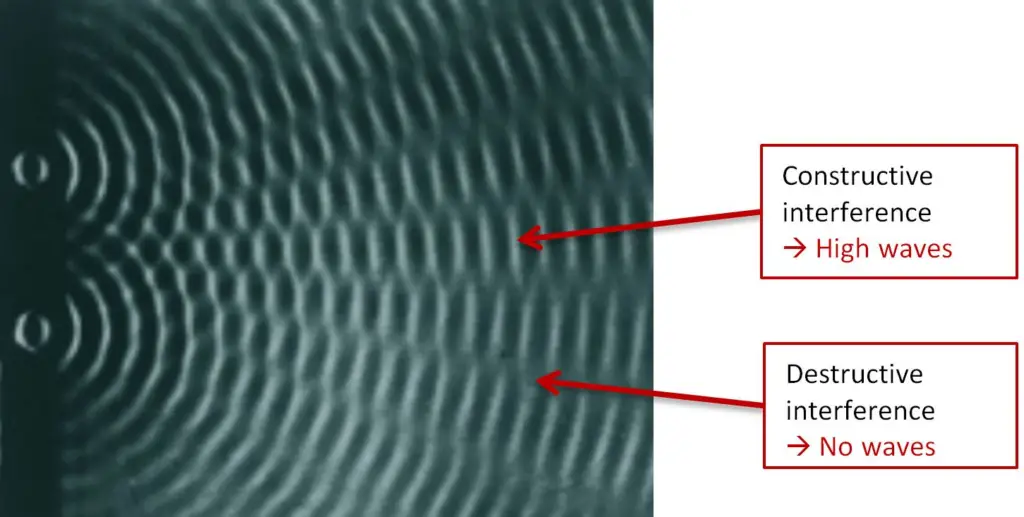
Anton Paar Wiki
- Explanation of Constructive and Destructive Interference:
- Constructive interference occurs when two waves with the same frequency and phase align their peaks and troughs, resulting in a larger amplitude wave.
- Destructive interference occurs when two waves with the same frequency and opposite phase align their peaks and troughs, leading to cancellation and a decrease in amplitude.
- Applications of Interference Phenomena:
- Diffraction Gratings: Interference patterns produced by diffraction gratings are used in spectrometers to disperse light and analyze its spectrum.
- Thin Film Interference: Interference in thin films causes iridescent colors in soap bubbles, oil slicks, and certain coatings.
Diffraction
Diffraction is a wave phenomenon that occurs when waves encounter an obstacle or aperture, causing them to bend and spread out around the edges. For electromagnetic waves, diffraction can affect how they propagate and interact with objects. The extent of diffraction depends on the wavelength of the wave and the size of the obstacle or aperture.

- Explanation of Diffraction of Electromagnetic Waves:
- When electromagnetic waves encounter an obstacle or aperture of comparable size to their wavelength, they bend and spread out, creating characteristic diffraction patterns.
- Examples of Diffraction Patterns:
- Single-Slit Diffraction: Light passing through a narrow slit creates a diffraction pattern with a central bright band and alternating dark and light bands.
- Double-Slit Diffraction: When light passes through two closely spaced slits, it produces an interference pattern of bright and dark bands.
Polarization
Polarization refers to the orientation of an electromagnetic wave’s electric and magnetic fields. Unlike scalar waves, such as sound waves, electromagnetic waves are transverse waves, meaning their oscillations occur perpendicular to the direction of wave propagation. Polarization states are essential in various applications and optical technologies.
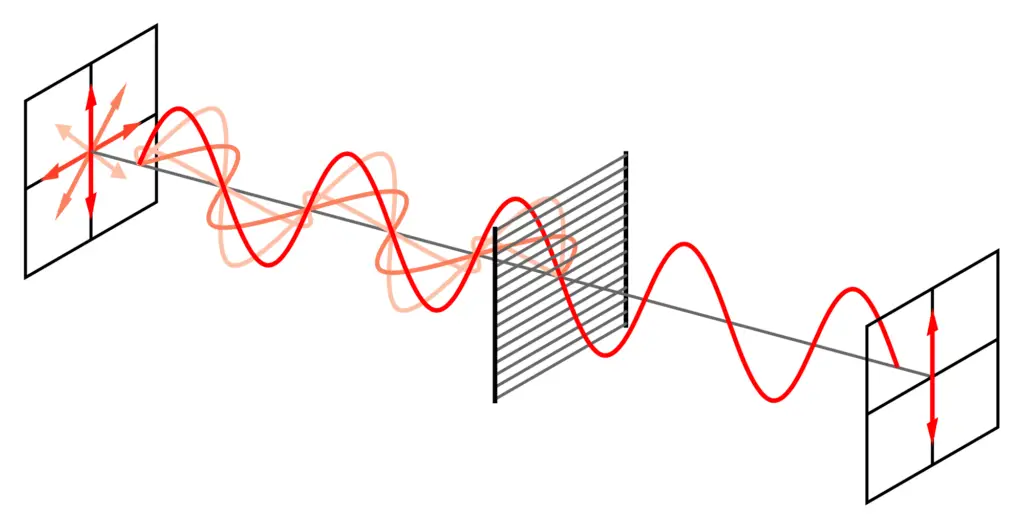
- Definition and Explanation of Polarization of Electromagnetic Waves:
- Polarization describes the direction of the electric field vector as the wave propagates.
- Electromagnetic waves can have different polarization states, including linear, circular, and elliptical polarization.
- Polarization States:
- Linear Polarization: The electric field oscillates in a straight line.
- Circular Polarization: The electric field rotates in a circle as the wave propagates.
- Elliptical Polarization: The electric field traces an elliptical path during propagation.
- Applications of Polarized Light:
- 3D Glasses: Polarized glasses are used in 3D movies to separate images intended for each eye.
- Sunglasses: Polarized sunglasses help reduce glare from reflective surfaces, enhancing visibility.
Reflection and Refraction
Reflection and refraction are phenomena that occur when electromagnetic waves encounter boundaries between different media. These interactions have significant implications in various optical devices and everyday experiences.

- Explanation of Reflection and Refraction of Electromagnetic Waves:
- Reflection occurs when waves bounce off a surface at the same angle at which they hit it.
- Refraction occurs when waves pass through a boundary between two media with different refractive indices, causing them to change direction.
- Laws of Reflection and Refraction:
- Law of Reflection: The angle of incidence is equal to the angle of reflection.
- Snell’s Law: Describes the relationship between the angles of incidence and refraction and the refractive indices of the media involved.
- Practical Applications of Reflection and Refraction:
- Lenses: Optical lenses use refraction to focus light and form images.
- Mirrors: Reflection from mirrors enables various optical devices, such as telescopes and cameras.
Understanding these wave characteristics of electromagnetic radiation is crucial for harnessing their potential in diverse applications. Whether in telecommunications, imaging technologies, or fundamental scientific research, these wave phenomena pave the way for innovations that continue to shape our modern world.
Wave-Particle Duality
Wave-particle duality is a foundational concept in quantum mechanics that revolutionized our understanding of the fundamental nature of particles, including electromagnetic radiation. It proposes that particles, such as photons (the discrete packets of electromagnetic energy), can exhibit both wave-like and particle-like behaviors, depending on the experimental conditions and the nature of the observation.
Historical Experiments and Theories Supporting Wave-Particle Duality
The wave-particle duality concept emerged in the early 20th century when physicists encountered perplexing phenomena in their experiments. Key historical experiments and theories that supported this concept include:
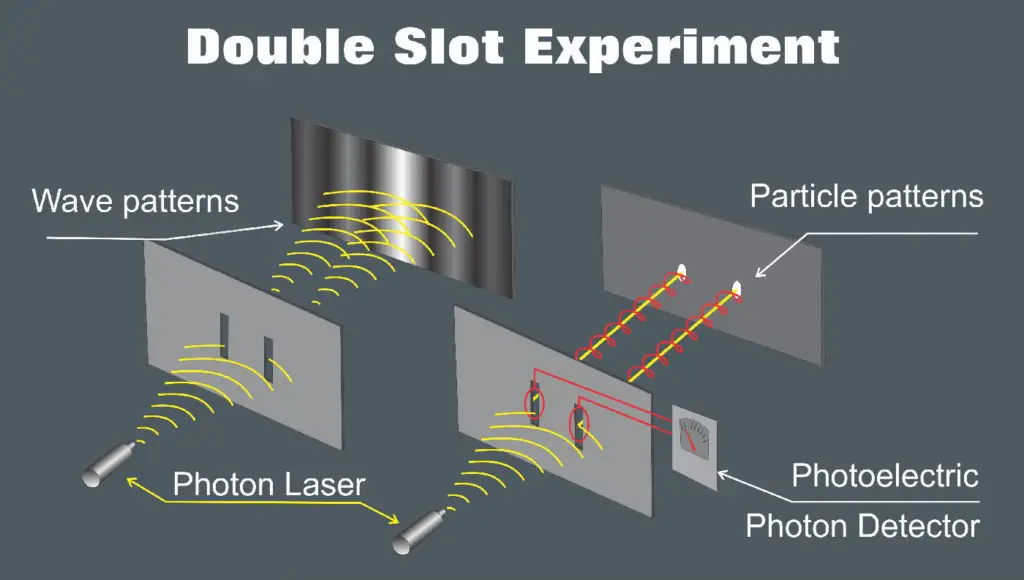
- Double-Slit Experiment: The landmark double-slit experiment, conducted with electrons, photons, and other particles, demonstrated that particles exhibit interference patterns similar to waves when passing through a double-slit barrier. This indicated that particles have wave-like characteristics.
- Photoelectric Effect: The photoelectric effect showed that when light (composed of photons) shines on a metal surface, it can eject electrons. This behavior could only be explained if light acted as discrete packets of energy (photons) interacting with electrons, rather than as a continuous wave.
- de Broglie Hypothesis: Louis de Broglie proposed that particles, like electrons and photons, have wave-like properties associated with their motion. He suggested that the wavelength of a particle is inversely proportional to its momentum. This hypothesis was later confirmed through experiments and became a fundamental concept in quantum mechanics.
Read Also
- AC circuit containing an inductor only
- AC circuit containing resistor only, class 12
- Representation of AC current and voltage by phasor diagram
- AC circuit containing resistor and inductor in series
Explanation of Wave-Particle Duality
Wave-particle duality challenges the classical view of particles as localized, solid entities with definite trajectories. Instead, it suggests that particles can display wave-like behaviors with spatial spread and superposition of states.
- Wave-Like Behaviors:
- Particle-Like Behaviors:
- Particle Detection: When interacting with a measuring device, particles can behave as localized entities, showing distinct positions and momenta.
- Quantized Energy: Photons and other particles carry discrete packets of energy, with the energy of each photon directly related to its frequency (E = hf), where h is Planck’s constant.
The Concept of Photons as Discrete Packets of Electromagnetic Energy
In the context of electromagnetic radiation, photons are the fundamental particles associated with light and other electromagnetic waves. They carry quantized energy and exhibit both wave-like and particle-like characteristics.
- Photons and Light:
- Photons have no mass and travel at the speed of light in a vacuum.
- The energy of a photon is directly proportional to its frequency (E = hf), where h is Planck’s constant (approximately 6.626 x 10^-34 joule-seconds).
- Implications in Quantum Mechanics:
- Quantum Theory of Light: Wave-particle duality led to the development of quantum theory, which describes the behavior of particles and electromagnetic radiation at the atomic and subatomic scales.
Wave-particle duality is a strange property of matter and energy that says that it can act like both waves and particles. This is different from what we are used to in the macroscopic world, where things are either waves or particles.
For example, light can behave like a wave when it passes through a slit and creates an interference pattern. But light can also behave like a particle when it is detected as a single photon.
This property of wave-particle duality is a fundamental concept in quantum mechanics, and it has important implications for our understanding of the universe. For example, it helps to explain how light can behave like both a wave and a particle, and it also plays a role in the development of technologies such as lasers and transistors.
Here is an analogy that might help you to understand wave-particle duality. Imagine that you are a small boat on a lake. If you are sailing in a straight line, you are behaving like a particle. But if you are bobbing up and down on the waves, you are behaving like a wave.
In the same way, matter and energy can behave like particles or waves, depending on how they are being observed. This is a strange and counterintuitive idea, but it is one of the fundamental principles of quantum mechanics.
Read Also:
- Rutherford atomic model: postulates, observations, and limitations, class 11
- Thomson model of atom: postulates, drawbacks, & significance, class 11
- Cathode Tube Ray Experiment class 11: working, procedure, observation, and conclusion
- Discovery of Electron class 11: chemistry, NCERT
- Discovery of proton class 11: chemistry NCERT
- Exploring the Bohr Atomic Model: A Comprehensive Guide
Frequently Asked Questions – FAQs
What is the wave nature of electromagnetic radiation?
The wave nature of electromagnetic radiation refers to the behavior of electromagnetic waves as they propagate through space. These waves consist of oscillating electric and magnetic fields perpendicular to each other and to the direction of wave travel. The concept describes various wave phenomena, including interference, diffraction, and polarization, exhibited by electromagnetic waves.
How do electromagnetic waves exhibit both wave-like and particle-like behaviors?
Electromagnetic waves, such as light and photons, display wave-like behaviors, such as interference and diffraction, as observed in the double-slit experiment. However, when interacting with matter or detectors, they also exhibit particle-like behaviors, where they can be detected as discrete packets of energy known as photons. This duality is a fundamental aspect of quantum mechanics.
What is the significance of the double-slit experiment in understanding wave-particle duality?
The double-slit experiment is a crucial demonstration of wave-particle duality. When particles, such as electrons or photons, are passed through two closely spaced slits, they produce an interference pattern, similar to what is expected from waves. This indicates that particles possess wave-like properties and can interfere with themselves, suggesting they are not purely particles but also exhibit wave-like characteristics.
How does the wave nature of electromagnetic radiation impact technology and daily life?
The wave nature of electromagnetic radiation underpins numerous technologies and applications. It enables communication through radio waves and microwaves, powers medical imaging techniques like X-rays and MRI, and is crucial in optical technologies, such as telescopes and cameras. Additionally, it forms the basis for wireless communication, remote sensing, and various other scientific advancements that have become integral to modern life.
Why is understanding wave-particle duality essential for quantum mechanics?
Wave-particle duality is a fundamental concept in quantum mechanics, which describes the behavior of particles and electromagnetic radiation at the atomic and subatomic scales. It challenges classical notions of particles and provides a more comprehensive framework to explain the behavior of matter and energy in the quantum realm. By embracing wave-particle duality, quantum mechanics has become the cornerstone of modern physics, revolutionizing our understanding of the universe at its most fundamental level.
Stay tuned with Laws Of Nature for more useful and interesting content.



